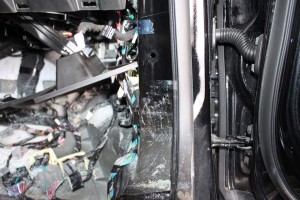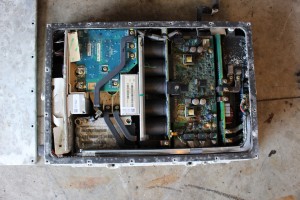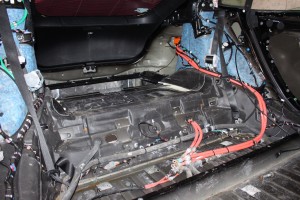Lifestyle
Repairing a Salvage Tesla Model S Due to Flood Damage
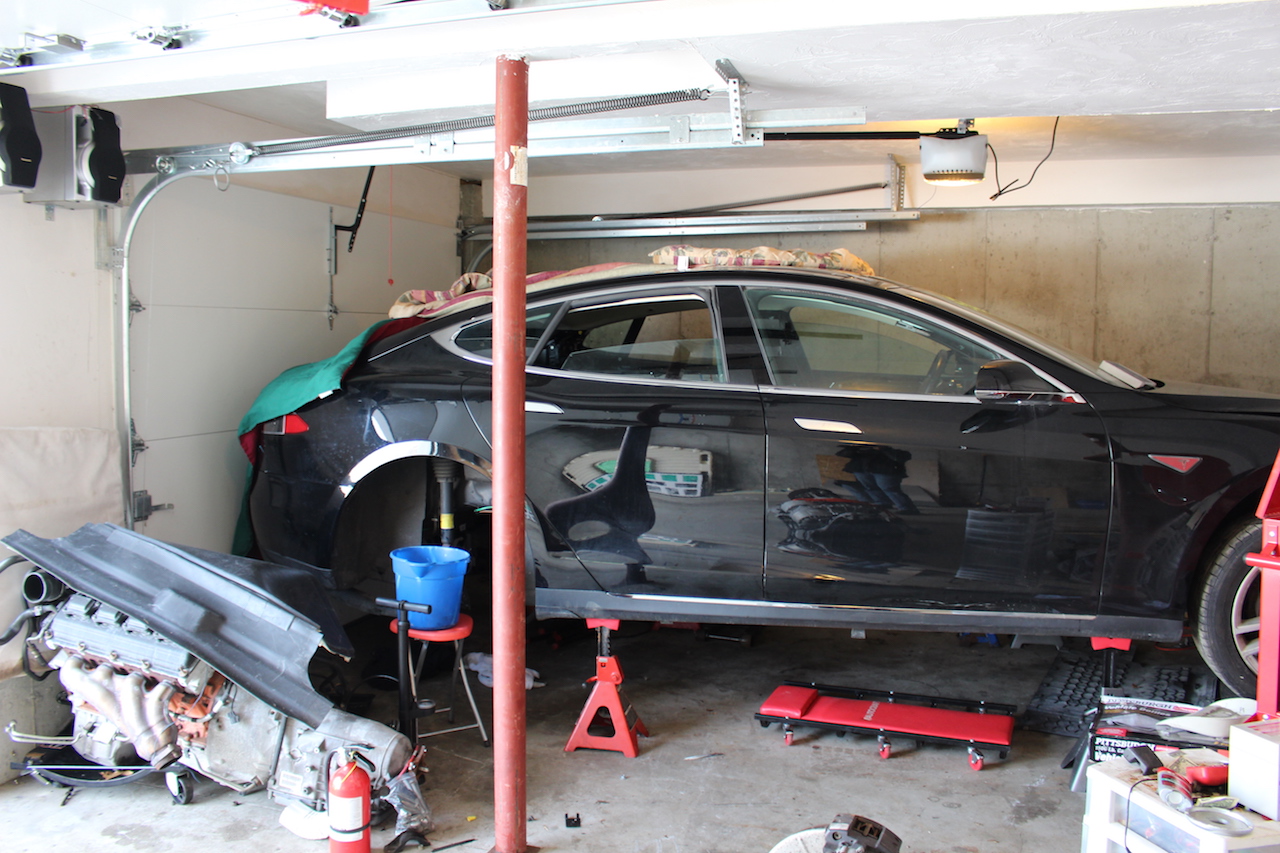
I’m a frequent visitor to the Tesla and TMC forums, and every once in a while I find myself getting sucked into the depths of a captivating story. This was Bonnie’s journey to her #2 Signatures Series Model X a few months back, but more recently it’s a story about a guy attempting to repair a salvage Model S due to flooding.
The thread was fascinating to follow, but what made it even more appealing for me was that the person lived in the same state as me. It’s rare to see any Tesla related news here in New England hence I jumped at the opportunity and decided to reach out to the person.
Rich was his name and he was gracious enough to let me visit him and ask a ton of questions about his project. I’ve outlined some of the feedback that I received from Rich and posted photos that I took of the salvage Model S project car while there. I hope you enjoy the following story as much as I have.
Introduction
Rich, known as Btr_ftw on TMC forums, works in the Information Technology space in Boston, MA by day. By night, in the little spare time he has, he takes vehicles apart and puts them back together again in better shape than they started in. Rich has bought and restored salvage vehicles before and even had a couple of extra engines sitting around in his garage when I visited.
Here’s a list of questions that I asked Rich while I was there, along with a summarized response that I put together based on information that came out of our dialogue together.
Do you have an engineering, electrical, computer, or mechanic background?
Being in the Information Technology space, Rich is comfortable around computers and electronics. His prior experience in repairing salvaged vehicles gave him the skills needed to take on this extreme project.
Do you own a model S?
Yes. Rich owns a Model S – the salvage one he is restoring! It’s his first Tesla.
How did you become familiar with Tesla Motors and their cars?
Rich said he heard about a new electric car company years ago through a friend. The friend informed him that the company was producing Roadsters and looking to venture into building sedans.
Rich eventually had the opportunity to test drive his friend’s Model S and quickly fell in love the vehicle’s performance. Despite wanting to own one, Rich couldn’t justify making such an expensive purchase especially since he only had a 2 mile daily commute to the local train station.
Purchasing a Salvage Model S
How did you end up purchasing a salvage Tesla Model S?
Rich was looking for his next project. Having heard many great things about the Model S, he took to the internet to find a salvage one.
He eventually found a 2012 Model S 85 online and purchased it for $14,000, including delivery, after having only seen a few pictures of the car. The car was reported as a total loss after having suffered severe flood damage.
Was it difficult to transport the car?
Getting the car delivered to his house was pretty easy, but getting it into his garage was a real bear. The Model S is a very heavy car.
And because the car was salvaged due to flood damage, the emergency brakes were locked so none of the wheels would turn. Imagine trying to move a near 5,000 pound car that has inoperable wheels and, to make matters worse, you are by yourself. Most people would have called for help or given up here, but Rich got creative instead.
One by one, Rich jacked up each wheel and put a wheel dolly beneath each of them. But even with all 4 wheels on dollies, the heavy car wouldn’t budge. Next he took a truck he had rebuilt and positioned it behind the Model S along with a big foam pad nuzzled between the two vehicles and began to slowly push the Model S into his garage. It was a tight fit but he was able to squeeze it into the garage.
Repairing a Flooded Tesla Model S
Were you concerned about not being able to repair it?
Rich has taken on projects like this before and thinks he has a good chance of repairing the Model S, but he also knows that parts for the Model S are hard to come by and very expensive. Above the water line, the parts are in great shape and could be easily sold to recoup his entire investment should he need to resort to that.
In Massachusetts you have the right to request service manuals for the Model S. Did you get access to them? Have they been helpful?
Rich did access the service manuals. The only requirement is that you live in the state of Massachusetts. You have to confirm that and then pay for the access. Payment also includes an address verification check to ensure you do have a mailing address in MA.
Service manual access is time limited. You can get access for a day for $95, but for a years’ worth of access it will set you back about $3,500. Rich has used a few day’s worth of access and has taken copious notes for the tricker parts, but mostly he’s learning through experience and with help from fellow TMC members.
How much information did you have about the salvage car before buying it?
Just 7 pictures and a brief summary that indicated it had flood damage. They left out some really useful information that would have been helpful — like the fact that it was saltwater! Saltwater and electronics do not get along well together.
Do you have any help or contacts at Tesla?
Rich is working by himself on this project but looks forward to the day when he can drive this Model S to a local Tesla Service Center and let them know it was once a salvage.
People following your story are concerned for your safety. What kind of safety precautions are you taking?
Rich confirmed that the main battery pack had shut itself down and disconnected power. He’s since isolated the power cables to ensure things remain that way. Rich is in no hurry to rush through the project and is methodically approaching the problem step-by-step.
How did you decide where to start?
After discarding most of the unrepairable items, Rich started with the 17″ touchscreen to see if it still worked. It did!
What are the most important things you’ve found out so far?
Rich was super excited when the 17″ touchscreen came on (albeit with dozens of warnings) and he could get the browser working over the car’s 3G connection. A working 17″ touchscreen and main control unit (MCU) is worth quite a bit of money by itself so it was quite a relief to see it working.
What are the biggest challenges you’ve faced so far?
Getting the car into the garage was certainly a big one. The car’s weight is a constant that he has to learn to work around. That and also being careful when handling the high power electronics.
Was there anything that was completely unexpected that you’ve found?
Flood damage was expected, the fact that it was saltwater was completely unexpected and added a huge bump to the whole process. With saltwater there’s a lot more damage done to the electronics and many of the parts cannot be easily repaired. What was originally a big remove-dry-and-replace project is now a remove-get replacement-replace project.
A lot of the process turned into finding out which pieces were damaged by saltwater. The charger, once removed, didn’t look too bad on the outside but on opening it the electronics inside were obviously beyond repair.
What are the the things you’ve been the most excited and happy about through this process?
The Model S is well designed and put together. While it’s a big project, there are surprisingly few parts that Rich has to deal with and keep track of which makes the job a bit less formidable.
What are the big projects coming up for this salvage process?
Removing the battery pack and inspecting it is a major task that Rich looks to take on in the near future. He has a strategy in mind for how he’s going to do that and is looking forward to performing the work. Rich doesn’t hold a lot of hope for the viability of the huge battery pack after full saltwater immersion, though.
Another big piece of the project is finding a second salvage Model S that has working parts which could be used to replace the damaged parts from his project vehicle.
Assuming he can find this second salvage Model S at the same cost, Rich could hypothetically drive away in a Model S for $28,000. There would likely be a lot of redundant parts so he could always sell those to further offset some of his expenditures.
What’s Next?
How much support are you getting from the Tesla community?
TMC has a real mix of people. Some people repeatedly tell him he lost/wasted his money etc. Others cheer him on and are interested in his progress. Still others are jumping in with concrete advice and helping him however they can. Sorting the noise from the good advice is work for him, but the help Rich gets is worth dealing with the noise.
I understand this is a spare-time project, how much time have you put into this so far?
Rich has only spent about 20 hours on this project so far, putting in a couple hours a night each week.
How much time do you think you’ll spend on the project?
Rich has no set timeline for the project but is enjoying the experience and the learning. It’s still too early to tell how long the entire project will take. A lot of the time spent will depend on the availability of parts.
Is the goal to get the Model S running again or to understand how the car is built and works?
Rich was very clear that his goal is to end up the proud owner and driver of a salvage Model S. The project is done when he’s driving that Model S.
What will you do next after this project with the knowledge and experience you’ve gained?
Rich is already getting good interest from the Tesla community and recently from local owners with out-of-warranty Model S’ that need some help. While not interested in leaving his current career, Rich sees a growing opportunity in this area as Model S’ age and Teslas service centers remain overwhelmed.
How can people best follow along your project?
I tried to address most of the frequently asked questions through this post, but I’d encourage you to go follow along and cheer him on via his forum thread. Rich doesn’t have a lot of time to do his own blog but will occasionally post updates and gather ideas from the community.
Summary
Repairing a salvage car of any type is a daunting task. To do that on Electric Vehicle, even more so. And then to do it with a vehicle of limited production and limited public knowledge brings that to another level of difficulty.
Rich has a great attitude and obviously loves doing what he’s doing. He’s enjoying the work and is learning along the way. Rich and I spoke for a couple hours while I visited, and it was amazing to see how much intricate detail he knows about the Model S. He would point out each individual system of the car and tell me what each component did, and how, but also explain how each part routed through the car.
One simple example of his knowledge and appreciation for the Model S is the air compressor for the air suspension. Rich said most manufacturers put them in the trunk and bolt them to the frame, but Tesla mounted theirs on rubber gaskets and towards the front of the car to avoid any noise and vibrations that would ordinarily be felt in the cabin.
I’m really going to enjoy following along Rich’s project. I’ll certainly be rootin’ him on and hope to see him drive his Model S one day here in New England.
Detailed pictures can be found over on flickr

Lifestyle
Tesla Model S Plaid battles China’s 1500 hp monster Nurburgring monster, with surprising results
There is just something about Tesla’s tuning and refinement that makes raw specs seem not as game-changing.
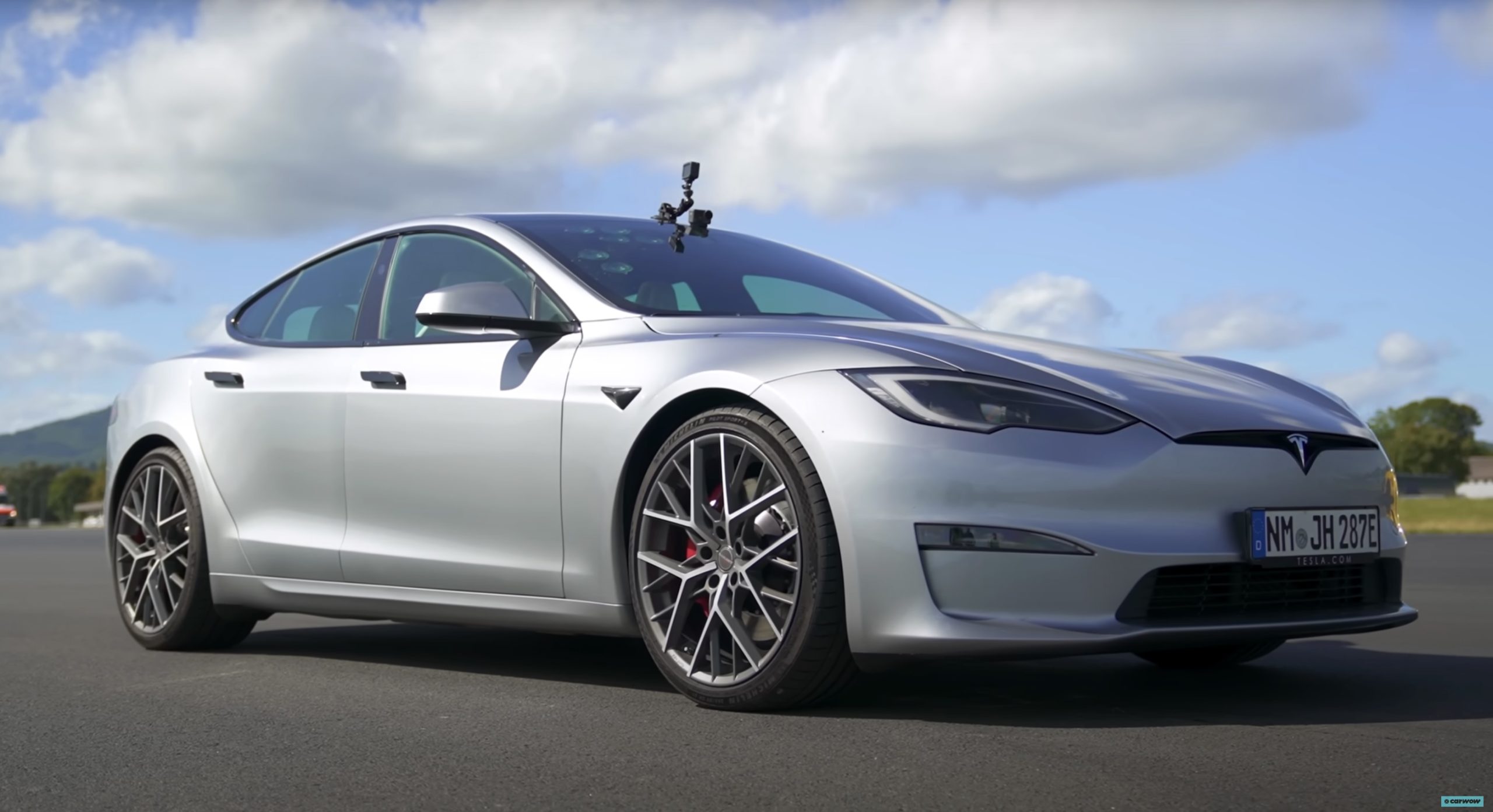
The Tesla Model S Plaid has been around for some time. Today, it is no longer the world’s quickest four-door electric sedan, nor is it the most powerful. As per a recent video from motoring YouTube channel Carwow, however, it seems like the Model S Plaid is still more than a match for some of its newer and more powerful rivals.
The monster from China
The Xiaomi SU7 Ultra is nothing short of a monster. Just like the Model S Plaid, it features three motors. It also has 1,548 hp and 1,770 Nm of torque. It’s All Wheel Drive and weighs a hefty 2,360 kg. The vehicle, which costs just about the equivalent of £55,000, has been recorded setting an insane 7:04.957 at the Nurburgring, surpassing the previous record held by the Porsche Taycan Turbo GT.
For all intents and purposes, the Model S Plaid looked outgunned in Carwow’s test. The Model S Plaid is no slouch with its three motors that produce 1,020 hp and 1,420 Nm of torque. It’s also a bit lighter at 2,190 kg despite its larger size. However, as the Carwow host pointed out, the Model S Plaid holds a 7:25.231 record in the Nurburgring. Compared to the Xiaomi SU7 Ultra’s record, the Model S Plaid’s lap time is notably slower.
Real-world tests
As could be seen in Carwow’s drag races, however, Tesla’s tech wizardry with the Model S Plaid is still hard to beat. The two vehicles competed in nine races, and the older Model S Plaid actually beat its newer, more powerful counterpart from China several times. At one point in the race, the Xiaomi SU7 Ultra hit its power limit due to its battery’s temperature, but the Model S Plaid was still going strong.
The Model S Plaid was first teased five years ago, in September 2020 during Tesla’s Battery Day. Since then, cars like the Lucid Air Sapphire and the Xiaomi SU7 Ultra have been released, surpassing its specs. But just like the Model Y ended up being the better all-rounder compared to the BYD Sealion 7 and the MG IM6, there is just something about Tesla’s tuning and refinement that makes raw specs seem not as game-changing.
Check out Carwow’s Model S Plaid vs Xiaomi SU7 drag race video below.
Lifestyle
500-mile test proves why Tesla Model Y still humiliates rivals in Europe
On paper, the BYD Sealion 7 and MG IM6 promised standout capabilities against the Model Y.

BYD is seeing a lot of momentum in Europe, so much so that mainstream media has taken every opportunity to argue that the Chinese automaker has beaten Tesla in the region. But while BYD sales this year in Europe are rising and Tesla’s registrations remain challenged, the raw capabilities of vehicles like the Model Y are difficult to deny.
This was highlighted in a 500-mile challenge by What Car? magazine, which showed that the new Tesla Model Y is more efficient, cheaper to run, and more reliable than rivals like the BYD Sealion 7, and even the nearly 400 KW-charging MG IM6.
Range and charging promises
On paper, the BYD Sealion 7 and MG IM6 promised standout capabilities against the Model Y. The Sealion 7 had more estimated range and the IM6 promised significantly faster charging. When faced with real-world conditions, however, it was still the Model Y that proved superior.
During the 500-mile test, the BYD nearly failed to reach a charging stop, arriving with less range than its display projected, as noted in a CarUp report. MG fared better, but its charging speeds never reached its promised nearly-400 kW charging speed. Tesla’s Model Y, by comparison, managed energy calculations precisely and arrived at each stop without issue.
Tesla leads in areas that matter
Charging times from 25% to 80% showed that the MG was the fastest at 17 minutes, while Tesla and BYD were close at 28 and 29 minutes, respectively. Overall efficiency and cost told a different story, however. The Model Y consumed 19.4 kWh per 100 km, compared to 22.2 for MG and 23.9 for BYD. Over the full trip, Tesla’s charging costs totaled just £82 thanks to its supercharger network, far below BYD’s £130 and MG’s £119.
What Car? Magazine’s testers concluded that despite BYD’s rapid sales growth and the MG IM6’s seriously impressive charging speeds, Tesla remains the more compelling real-world choice. The Model Y just offers stability, efficiency, and a proven charging infrastructure through its Supercharging network. And as per the magazine’s hosts, the Model Y is even the cheapest car to own among the three that were tested.
Watch What Car? Magazine’s 500-mile test in the video below.
Lifestyle
Tesla Cybertruck slapped with world’s least intimidating ticket, and it’s pure cringe
One cannot help but cringe and feel second-hand embarrassment at the idea of a person just driving around with a stack of these babies.

A Cybertruck parked at Stanford Shopping Center in California was recently hit with what might be the most try-hard piece of paper ever slipped under a wiper blade: a “fake citation” accusing the driver of supporting a “fascist car.”
The note, shared on X by Tesla staff program manager Ryan Torres, quickly made the rounds on X, where it quickly gained attention as an example of how not to protest.
The world’s least intimidating ticket
According to the citation, the supposed “violation” was “driving a fascist car.” The remedial action? Take the bus, call an Uber, or ride a bike. The note also dubbed Elon Musk a “chainsaw-wielding Nazi billionaire.” Now, protests against Tesla and Elon Musk have become commonplace this year, but one cannot help but cringe and feel second-hand embarrassment at the idea of a person just driving around with a stack of fake anti-Tesla/Musk citations.
Torres pointed out the irony himself in his post on X. Tesla currently employs over 140,000 Americans, and SpaceX has put the U.S. firmly back at the top of space technology. As Torres put it, maybe the person behind the world’s least intimidating ticket should “read a book on innovation before vandalizing” other people’s property.
Peak performative clownery
Not to mention that the fake ticket’s logic collapses under its own weight. EVs like the Cybertruck are literally designed to reduce emissions, not “destroy the economy.” If anything, Tesla has bolstered the United States’ economy by fueling jobs in engineering, manufacturing, and clean energy. It’s not the first time a Tesla has been the target of vandalism or politically charged notes, but this one stands out for sheer cringe value.
Torres summed it up neatly: “Peak clownery.” On that point, at least, the citation earns full marks. In a way, though, perhaps cringe fake tickets are not as bad as the literal firebombs that were being thrown at Tesla stores and cars earlier this year because some critics were gleefully misinformed about Elon Musk.



